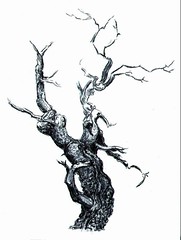The story appeared in the Lexington (Kentucky) Herald-Leader last September (2008) and I think that's the best place to read about it (for as long as they have the article on there), since I don't feel right about quoting extensively from it and you can read all about it there.
They also have a 360 degree moving panorama of the basement walls on there, all of which are decorated. BUT, I also recommend you go to this page to see the panorama in a larger size. There is no article on this page, but it's nice to see the larger viewer.
I love everything about this. I know it had to be lots of fun to do, I would love to be surrounded by scenes like these, I like the idea of painting all the walls, and the "built-in-looking" furniture that's against the walls, the same cream color so that it can all be decorated with black markers (and also having so much of the room painted in such a light color makes the place look large and uncramped; besides, the black furniture looks great against the cream color).
I love the illusions, but of course the scenes were not intended to look photographically realistic. The non-existent third dimension is implied by perspective lines and by things being "behind" and "in front of" each other, etc., but we are quite aware that what we see is not at all real; we can only enter these scenes via our imagination, but this isn't difficult to do as we are surrounded by the "life size" drawn scenes, which come right up to and even in some places "leak into" and cover what's really in the room -- and the ideas (art, good company, pleasures of the mind) are so appealing.
To me, art -- as opposed to copied or intuitively inspired decoration, for instance, or as opposed to photographs taken by someone who is not artistic but only wants to "record" the scene (for another instance) -- doesn't spell things out for us showing us every detail in a "realistic" manner; it suggests things to us; the less specific and "real" it is, the more we enter into it. Art involves the viewer's imagination, and this is what makes us "feel" something when we look at it -- We are, truly, involved in it.
For instance, the curved stairway that appears to go behind the wall is far from realistic. Even a cat or a very young child would realize that it really doesn't exist behind that wall, but that doesn't prevent me from wishing I could climb the stairs to see if there are more books up there, every time I see it come around. It doesn't matter that I know I couldn't really climb those stairs - In my imagination I certainly can, and do. And I imagine what those men are talking about -- With characters like those gathered together there must be fascinating conversations taking place (and I think of other people I'd like to see there with them).
To me, suggestions are more interesting than the real thing because via my imagination I can have an adventure and endless fun -- What is at the top of the stairs? I get to see, in my mind, what I want it to be, and seeing it again (and again) is no less enjoyable as I can recreate (or rearrange) it unendingly.
Also, I noticed that the three-dimensionality of the actual stairway is greatly enhanced by comparison with the illusions drawn on the walls. The real stairwell looks sooooo concave.
And there's the fact that he didn't just draw "decorations" on the walls - He drew what he would love to be surrounded by; for instance, the ancient vases, the library with its shelves and shelves of books, fictional and historical characters (and his father) who are especially meaningful to the artist, the 'paintings,' the what looks like a long carpeted hallway that I wish I could walk to the end of, and so on.
And there's a lot of enlivening tension caused by the fact that there are many real, three-dimensional, objects against the wall that were painted the same cream color as the wall which were drawn on, too. That was a clever idea. Those real items look all the more "bulgy" (while, for instance, the actual stairwell looks all the more concave) because of the contrast with the flat walls that have been drawn on in the same manner.
There is another contrast, too: The contrast of a basement, which makes me at least think of a cold, dank, airless and depressing place full of junk, and the scenes portrayed on its walls, which makes me think of art, books, and interesting people and conversation in a very comfortable-looking place.
What could be more fun than this, in this particular place? For me, I don't think anything else could compete. If I were the artist, I would probably just think of more ways to integrate the "real" with the "unreal." I would guess he has already thought about the same kinds of things.



2 comments:
Unusual approach to an almost "practical" art, but I like it.
Thinking about what you wrote, David, I just re-wrote some of this post and added quite a lot more! I intended only to leave a comment here, but realized I needed to add it to the post.
Post a Comment